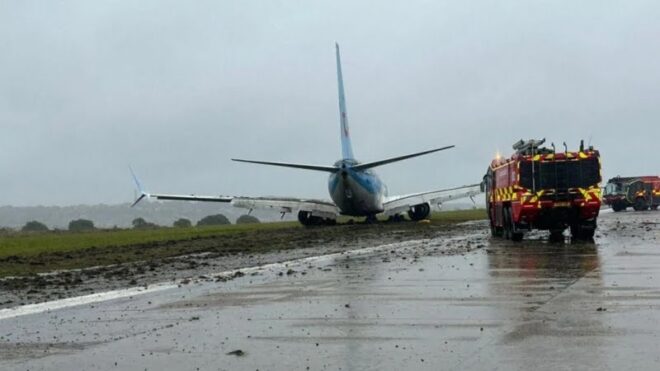
A TUI holiday flight from Corfu experienced a dramatic landing at Leeds Bradford Airport when it veered off the runway shortly after touchdown. The Air Accidents Investigation Branch (AAIB) recently released a report detailing the sequence of events and contributing factors to this incident, which occurred amid challenging weather conditions linked to Storm Babet. Thankfully, none of the six crew members or the 195 passengers sustained any injuries, despite the aircraft coming to rest in muddy terrain.
The incident took place during Storm Babet, which brought gusty winds and unsettled weather to the area. The report notes that the plane touched down amidst these windy conditions, complicating the landing process. While aircraft are generally capable of handling such circumstances, the added difficulty for the flight crew in maintaining control upon touchdown was evident during this particular incident.
Shortly after landing, the aircraft began to veer to the left, prompting the flight crew to intervene and try to correct the plane’s deviation from the runway’s centerline. Despite these efforts, they encountered a significant and unusual judder from the nosewheel gear. The AAIB report describes the judder as unexpected, leading to uncertainty among the crew regarding its potential impact on the aircraft’s control and stability.
The AAIB investigation identified the root cause of the incident as a “catastrophic failure” of a nosewheel bearing. The bearing failure likely occurred during the plane’s rollout, causing abnormal vibrations and an unstable landing experience. As the aircraft continued along the runway, the failure of the nosewheel bearing resulted in excessive juddering, which complicated the pilot’s ability to correct the deviation using standard procedures.
The AAIB report indicates that while there were no mechanical barriers preventing the use of additional rudder or braking to keep the aircraft on the runway, the unexpected nature of the nosewheel juddering could have affected the crew’s decision-making and response. The uncertainty around the cause and effect of the juddering might have led to hesitation in applying further corrective measures, ultimately allowing the plane to veer off course.
The aircraft came to a halt after leaving the paved surface of the runway, eventually stopping in the muddy ground nearby. Emergency services were quickly dispatched to the scene, where they assisted with the safe evacuation of all passengers and crew. Although the aircraft sustained some minor damage, it was not considered significant enough to pose a direct threat to the passengers’ safety.
After the incident was managed and the aircraft secured, operations at Leeds Bradford Airport were temporarily suspended. The runway closure affected numerous flights, resulting in delays and some cancellations. However, airport authorities worked swiftly to clear the area and reopened the airport the following day.
Following the runway excursion, TUI issued a public apology to all affected passengers. Many travelers experienced disruptions due to the temporary closure of Leeds Bradford Airport, leading to a cascade of delays and adjustments in flight schedules. In the aftermath of the incident, airport management prioritized reviewing and enhancing emergency protocols to ensure timely responses to similar situations in the future.
For passengers on board the TUI flight, the situation, though frightening, ended without injuries or major harm. Many later recounted the tense moments when the aircraft left the runway, describing the sudden vibrations and sense of uncertainty before coming to a stop.
In its report, the AAIB made several observations about the incident and offered suggestions to improve safety and prevent similar occurrences in the future. Key points include:
1. Nosewheel Bearing Maintenance and Inspection: The report highlighted the need for heightened awareness and regular checks on nosewheel components, including bearings. It emphasized the importance of early detection of potential issues during routine maintenance inspections.
2. Pilot Training for Unusual Landing Situations: The AAIB noted that while the crew responded in line with standard procedures, there may be a need for enhanced training programs that better prepare flight crews for unusual events, such as unexpected nosewheel juddering. Simulated training scenarios could help improve decision-making during similar circumstances.
3. Further Investigation into Bearing Failures: The report recommended that airlines and maintenance organizations conduct more thorough research into the causes of bearing failures, aiming to develop preventive measures that would minimize the risk of future incidents.
The Leeds Bradford Airport incident underscores the challenges faced by the aviation industry when contending with adverse weather conditions. Although airports and aircraft are generally well-equipped to manage gusty winds and storms, this incident demonstrates that unforeseen mechanical failures can still pose risks. The AAIB’s report serves as a reminder that even with advanced technology and skilled flight crews, aviation safety requires constant vigilance and preparedness for the unexpected.
TUI’s Response and Commitment to Safety
In addition to the initial apology extended to affected passengers, TUI reiterated its commitment to upholding the highest safety standards across its fleet. The airline stated that it would review the AAIB’s findings in detail and collaborate with its maintenance partners to implement any recommended changes.
The company also emphasized that it conducts regular safety audits and inspections of its aircraft and would work to ensure that any lessons learned from this incident would be applied to future operations. Safety remains a top priority for TUI, which aims to provide a secure and comfortable travel experience for all customers.